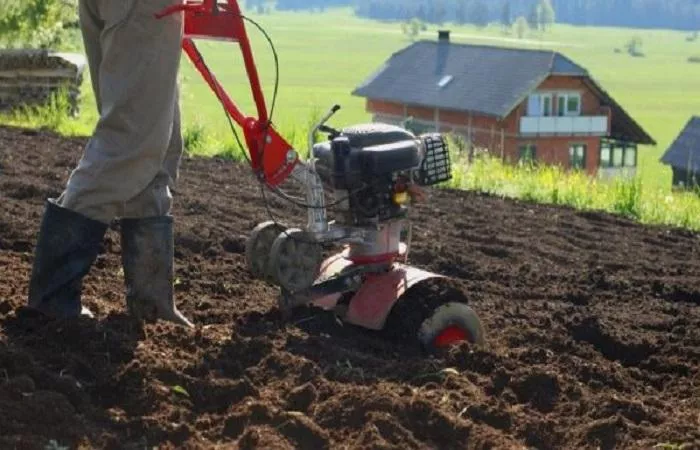For what purpose do they loosen the soil around plants: causes and what contributes
It's hard to find crops that like heavy, dense soil. The root system of any plant needs access to moisture and oxygen. The most common answer to the question of why it is necessary to loosen the soil around plants is to increase the air permeability and moisture permeability of the soil. However, do not forget about the additional benefits: the destruction of young weeds, the prevention of parasitic diseases.
Why loose structure is important for soil
Heavy, clumpy soil poorly passes water, fertilizers and oxygen into the deep layers.After rain, it forms a hard crust on the surface, through which water, instead of flowing to the roots, flows into the grooves and quickly evaporates. In compacted loamy soil or under a thick crust, the roots of the plant literally suffocate from lack of oxygen, grow more slowly, thin young roots may die.
Loose earth, on the contrary, forms internal reservoirs, small capillaries in which moisture remains for several days and is available to plants. The need for watering is reduced (because of this, loosening is often called "dry watering"). The best effect will be obtained if it is combined with mulching and fertilizing the beds.
Useful loosening properties:
- promotes soil air permeability;
- promotes better absorption of fertilizers;
- prevents rapid evaporation of moisture;
- destroys pests by destroying their nests;
- damages the root system of weeds.
Soil looseness is especially important when growing a crop from seed. Seedlings may not have enough nutrients in the grain to reach the sun through the hard surface crust of the soil (especially small seeded plants like carrots or parsley).

Loosening terms
For the first time, loosening is carried out in the spring, when the soil is prepared for planting. Loosen immediately after digging the beds to a great depth (up to 25 cm), then level.
After planting seedlings, tillage is carried out two weeks later. If the crop is grown from seeds, then loosening is recommended to start after germination. If there is a need to loosen the ground before germination (a crust has formed on the surface or the culture is demanding on airiness, lightness of the soil, for example, carrots and onions), it is necessary to loosen very carefully, exactly to the depth that the crust occupies (2-3 cm).
In the future, loosening is carried out with a frequency of 1-2 times a week. The frequency is determined based on the state of the soil. It is recommended to loosen after rain, after watering or before fertilizing. Clay soils tend to be heavy, dense and require loosening more often than sandy and loamy soils.
In autumn, at the end of the gardening season, the beds are dug up and left until spring. Loosening is strictly not recommended: dry clods of soil freeze quickly and thoroughly, killing the larvae of parasitic insects stored in the soil.
How deep should it be
The depth of loosening depends on the season, as well as on the type of crop. In the spring before planting, it is the largest, and young shoots require careful treatment. In summer, the recommended depth is 5-7 cm.
It is important to remember: loosening is not digging up beds! It is impossible to turn up the fertile soil, which is located under the surface crust.

Crop care
Distinguish between continuous loosening (pre-planting and pre-emergence) and inter-bed loosening, which is carried out after the appearance of seedlings on the surface, at some distance from them. For young plants, the “protective zone”, in which it is not recommended to loosen the earth, is small, with the growth of bushes, its diameter increases to 10-15 cm.
Cucurbits are the most vulnerable to loosening - they have a delicate root system with abundant horizontal branching, so the beds should be loosened very superficially and carefully.
But cabbage crops (all types) always respond positively to loosening. Permissible depth - 6 cm or more.

After planting legumes and some root crops (carrots, potatoes), loosening should be carried out before the first shoots appear and even a thin crust should not form on the surface.
It is not recommended to loosen the beds with onions, beets and celery until the seedlings germinate and their thorough gardening.
Seedlings of garden trees also need loosening. However, their roots prefer to branch in a horizontal direction under the very surface of the soil, so tillage is carried out superficially, to a depth of 4 cm.
Recommended
Bee honeycombs: what they consist of and how they are built, how they look and shape, what to do with them

Bee honeycombs have a unique structure and beneficial composition. However, they differ in varieties and are often used in traditional medicine.
Soil types: main types and how they differ, characteristics and how they are formed

The type of soil is considered an important condition for the full growth and development of plants. The soil is an important source of moisture and nutrients.
Soil grading: what is grading, its main purpose and indicators

Under the appraisal of soils understand the comparative definition of their quality. This procedure is carried out for the purpose of economic evaluation of agricultural land.




